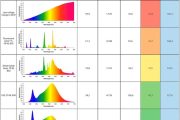Introduction
The solar spectrum is an absorption spectrum of different wavelengths. It is divided into two parts: visible light and invisible light. Visible light has a wavelength of 400-760nm. After being scattered, it is divided into 7 colors: red, orange, yellow, green, cyan, blue, and purple. When concentrated, it becomes white light. Invisible light is divided into two types: infrared light, which is located in the outer area of red light, has a wavelength greater than 760nm and a maximum length of 5300nm. The ultraviolet rays located outside the purple light have a wavelength of 290-400nm.
Sunlight has obvious biological effects. Plants can synthesize under the action of sunlight. Animal skin undergoes conversion of vitamin D under the action of sunlight. Infrared rays have a huge thermal effect, and ultraviolet rays have obvious bactericidal effects.
There are tens of thousands of absorption lines and emission lines of sunlight, which is an extremely rich treasure of solar information. The solar spectrum belongs to the G2V spectral type, and the effective temperature is 5770 K. 99.9% of the energy in solar electromagnetic radiation is concentrated in the infrared, visible and ultraviolet regions.
Solar radiation is mainly concentrated in the visible light part (0.4~0.76μm), and there are few parts of infrared light (>0.76μm) with wavelength greater than visible light and ultraviolet light (<0.4μm) less than visible light. Among the total radiant energy, more than 99% have wavelengths between 0.15 and 4 μm, and they are mainly distributed in the visible region and the red and ultraviolet regions. The visible region accounts for about 50% of the total solar radiation energy, and the infrared region accounts for about 43%. Solar radiation energy in the ultraviolet region is very small, accounting for only about 7% of the total.
The wavelength range of solar radiation observed on the ground is approximately 0.295 ~ 2.5 μm. Solar radiation with wavelengths shorter than 0.295 μm and greater than 2.5 μm cannot reach the ground due to the strong absorption of ozone, water vapor and other atmospheric molecules in the earth’s atmosphere.
the color of sunlight
The spectrum emitted by the sun on weekdays mainly comes from the black body radiation (Black Body Radiation) spectrum with an absolute temperature of about 6,000 degrees on the surface of the sun. The visible light has a wavelength range of 770 to 390 nanometers, and the invisible wavelength range is from 770 to 11590 nanometers. Electromagnetic waves of different wavelengths cause different color perceptions in human eyes. 770-622nm, felt red, 622-597nm, orange, 597-577nm, yellow, 577-492nm, green, 492-455nm, blue indigo, 455-390nm, purple.
Power distribution
The sun is the strongest, natural and stable natural radiation source, with a center temperature of 1.5*107 K and a pressure of about 1016 Pa. A polynuclear reaction that converts hydrogen to helium takes place inside.
The sun’s nucleation reaction releases huge energy, and its total radiant power is 3.8*1026 W, of which the part received by the earth is about 1.7*1017 W. The radiant energy of the sun is expressed by the solar constant, which is the value of solar irradiance measured outside the earth’s atmosphere at the average distance between the sun and the earth. Since the test data was available in 1900, its measured value has almost always been 1350W/㎡. The value of the earth’s surface after correcting the absorption and scattering of the atmosphere is about 2/3 of this value.
It is generally assumed that the sun’s radiation temperature is 5900K, and its radiation temperature decreases as the wavelength increases. According to the blackbody radiation theory, when the temperature of an object rises, the emitted radiation energy increases, and the peak wavelength shifts to the shortwave direction.
The wavelength range of solar radiation covers the entire spectrum of electromagnetic waves from X-rays to radio waves. Outside the atmosphere, the spectral distribution curves of the sun and the 5900K blackbody are similar. Affected by the absorption of various gas components in the atmosphere, the radiant energy of certain spectral regions is greatly attenuated when sunlight passes through the atmosphere and reaches the surface of the earth, resulting in some depressions in the spectral distribution curve.
Significance
The solar spectrum can be used to detect the chemical composition, temperature, pressure, motion, structural model of the solar atmosphere, and the generation mechanism and evolution of various activities, and can verify the radiation spectrum and confirm the abundance of various elements. The Zeeman effect of the solar spectrum in the magnetic field can be used to study the solar magnetic field.
The overall change in the solar spectrum is very small, but some spectral lines have larger changes. When the sun erupts, both extreme ultraviolet and soft X-rays will change greatly. Using the spectral change characteristics of these bands can study a variety of activities of the sun.
Therefore, improving the spatial resolution of the solar spectrum and expanding the observation band can greatly enhance the understanding of the sun and solar activities. Now a complete polarized radiation spectrum called the second solar spectrum has been detected. Using the second solar spectrum, a number of solar physics studies can be further carried out, and it may also become an effective method to detect the weak and turbulent magnetic fields of the sun.
Application of Spectroscopy in Air Pollution Detection
At present, the detection of atmospheric pollution gases mainly adopts the artificial light source differential absorption spectroscopy method, which inverts the atmospheric pollution status by measuring the spectrum of the artificial light source after passing through the atmosphere. However, the superiority of solar light source differential absorption spectroscopy has become increasingly prominent and has become a research hotspot in air pollution gas detection.
The measured spectrum under haze weather conditions shows an increase in the intensity of the long-wave part. In view of the wavelength resolution of the imaging spectrometer as high as 0.06nm, based on the solar radiation spectrum, spectral analysis technology can also be used to identify the content of gas components in the atmosphere.
Nitrogen dioxide molecules have obvious absorption in the 430nm-450nm waveband. If the concentration of nitrogen dioxide is different, it will cause changes in the solar radiation spectrum.
The influence of solar spectrum on plant growth
Scientific experiments have proved that different wavelengths of light have different effects on plant growth. Visible light blue-violet light and cyan light have a great effect on plant growth and the formation of young buds. This kind of light can keep plants elongating to form a short and thick form.
At the same time, blue-violet light is also the most important light that governs cell differentiation, and blue-violet light can also affect the phototropism of plants. Ultraviolet rays inhibit the formation of certain growth hormones in plants, thereby inhibiting the elongation of stems. Ultraviolet rays can also cause phototropic sensitivity and, like blue, violet and cyan light in visible light, promote the formation of anthocyanins.
Red light in visible light and infrared light in invisible light can promote the germination of seeds or spores and the elongation of stems. Red light can also promote the decomposition of carbon dioxide and the formation of chlorophyll.
The effect of the spectrum on the photosynthesis of plants The light that has a greater impact on plants is mainly divided into three categories, namely ultraviolet, visible and infrared. Let’s analyze these three types of light in detail below.
The radiant light in the first band is ultraviolet light that contains a lot of energy, but part of the ultraviolet light is absorbed by the ozone layer. Therefore, we are more concerned about the parts closely related to agricultural film: ultraviolet-b (wavelength 280-320nm) and ultraviolet-a (wavelength 320-380nm). These two wavelengths of ultraviolet light have different effects, such as: coloring the flowers of plants.
The second band of radiation is visible light (wavelength 400-700nm), which is equivalent to blue, green, yellow and red light, also known as PAR, which is the active area of photosynthesis, and is the most important visible light used by plants for photosynthesis Part.
Blue light and red light are the most important parts of the PAR spectrum, because riboflavin in plants can effectively absorb this part of light, while green light is not easily absorbed.
The radiant light in the third band is infrared, which can be divided into near infrared and far infrared. Near-infrared light (wavelength 780-3,000nm) is basically useless to plants, it only generates heat. Far infrared (wavelength 3000-50,000nm), this part of the radiation does not come directly from sunlight. It is a kind of radiation generated by molecules with thermal energy, which is easily lost at night.
Plants are most sensitive to red light spectrum and less sensitive to green light, and the most sensitive area of the spectrum is 400~700nm. This section of the spectrum is usually called the effective energy region of photosynthesis. Approximately 45% of the energy of sunlight lies in this section of the spectrum. Therefore, if an artificial light source is used to supplement the amount of light, the spectral distribution of the light source should also be close to this range.
The energy of the photons emitted by the light source varies with the wavelength. For example, the energy of wavelength 400nm (blue light) is 1.75 times the energy of 700nm (red light). But for photosynthesis, the effect of the two wavelengths is the same.
The excess energy in the blue spectrum that cannot be used for photosynthesis is converted into heat. In other words, the photosynthesis rate of a plant is determined by the number of photons that the plant can absorb in the 400-700nm range, and is not related to the number of photons sent by each spectrum. However, most people generally believe that the color of light affects the rate of photosynthesis.
Plants have different sensitivity to all spectra. This reason comes from the special absorption of pigments in the leaves. Among them, chlorophyll is the most known. But chlorophyll is not the only pigment useful for photosynthesis. Other pigments also participate in photosynthesis, so the photosynthesis efficiency cannot only consider the absorption spectrum of chlorophyll.
The difference in photosynthesis path is also not related to color. Light energy is absorbed by chlorophyll and carotene in leaves. Energy uses two photosynthetic systems to fix water and carbon dioxide into glucose and oxygen. This process uses all the visible light spectrum, so the effects of light sources of various colors on photosynthesis are almost the same.
Some researchers believe that the orange-red light has the greatest photosynthesis capacity. But this does not mean that plants should be cultivated in such a monochromatic light source. Regarding the morphological development and leaf color of plants, plants should receive a variety of balanced light sources.
In addition, the different wavelengths of light also have an impact on the photosynthesis products of plants. For example, red light is conducive to the synthesis of carbohydrates, and blue light is conducive to the synthesis of proteins and organic acids. Therefore, in agricultural production, the quality of crops can be improved by controlling the products of photosynthesis by influencing light quality.
Half of the plants in high mountains or plateau areas have short stems, reduced leaf area, developed furry, increased chlorophyll, anthocyanins in the stems and leaves, and flowers with color. This is because the temperature on the high mountains is low and the Plus there are more ultraviolet rays.





